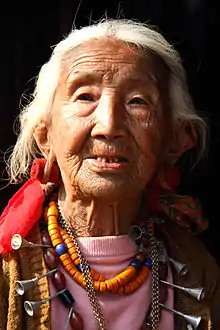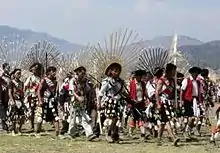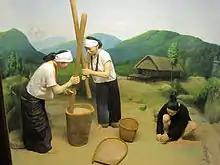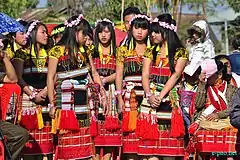List of Naga tribes
Naga is an umbrella term for several indigenous communities in North-East India and Upper Burma. The word Naga originated as an exonym. Today, it covers a number of tribes that reside in Nagaland, Manipur, Assam and Arunachal Pradesh states of India, and also in Myanmar.
Before the arrival of the British, the term "Naga" was used in Assam to refer to certain isolated tribes. The British adopted this term for a number of tribes in the surrounding area, based on loose linguistic and cultural associations.
S. R. Tohring (2010) lists 66 Naga tribes[1] whereas Kibangwar Jamir (2016) lists 67 tribes.[2] The 1991 Census of India listed 35 Naga groups as Scheduled Tribes: 17 in Nagaland, 15 in Manipur and 3 in Arunachal Pradesh.[3]
Naga tribes
| Tribe | Country | Recognized as Scheduled Tribe in | Reference for classification as Naga | Comments |
|---|---|---|---|---|
| Angami | India | Nagaland | S. R. Tohring, 2010 | |
| Anāl | India, Myanmar | Manipur | S.R. Tohring, 2010 | |
| Ao | India | Nagaland | S. R. Tohring, 2010 | |
| Chakhesang | India | Nagaland | ||
| Chang | India | Nagaland | S. R. Tohring, 2010 | |
| Chirr | India | Nagaland | S. R. Tohring, 2010 | |
| Chiru | India | Manipur | S. R. Tohring, 2010 | |
| Chothe | India | Manipur | S. R. Tohring, 2010 | |
| Inpui | India | Manipur | S. R. Tohring, 2010 | |
| Kharam (also Purum) | India | Manipur | S. R. Tohring, 2010 | |
| Khiamniungan (or Khiamnungam) | Myanmar, India | Nagaland | S. R. Tohring, 2010 | Also known as Nokow (Noko) in Myanmar. |
| Konyak | Myanmar, India | Nagaland | S. R. Tohring, 2010 | |
| Lamkang | India | Manipur | S. R. Tohring, 2010 | |
| Lainong | Myanmar | S. R. Tohring, 2010 | Also known as Htang ngan | |
| Liangmai | India | Nagaland, Manipur | Part of Zeliangrong | |
| Lotha | India | Nagaland | S. R. Tohring, 2010 | |
| Makury (sometimes spelt Makuri) | Myanmar, India | S. R. Tohring, 2010 | Considered part of Yimchunger in Nagaland, India | |
| Mao (also Ememei) | India | Manipur | S. R. Tohring, 2010 | Khrasi ][4] |
| Maram | India | Manipur | S. R. Tohring, 2010 | |
| Maring | India | Manipur | S. R. Tohring, 2010 | |
| Monsang | India | Manipur | S. R. Tohring, 2010 | |
| Moyon | Myanmar, India | Manipur | S. R. Tohring, 2010 | Moyon Naga.[5][6][7] |
| Nocte (or Nokte) | India | Arunachal Pradesh | S. R. Tohring, 2010 | Part of Tangshang Naga. |
| Para | Myanmar | S. R. Tohring, 2010 | ||
| Phom | India | Nagaland | S. R. Tohring, 2010 | |
| Pochury | India | Nagaland | S. R. Tohring, 2010 | |
| Poumai | India | Manipur | S. R. Tohring, 2010 | |
| Rengma | India | Assam, Nagaland | S. R. Tohring, 2010 | |
| Rongmei | India | Assam, Manipur and Nagaland | S. R. Tohring, 2010 | Part of Zeliangrong |
| Sangtam | India | Nagaland | S. R. Tohring, 2010 | |
| Sumi (or Sema) | India | Nagaland | S. R. Tohring, 2010 | |
| Tangkhul | India, Myanmar | Manipur | ||
| Tangsa (or Tase in language coding name) | India, Myanmar | Arunachal Pradesh | S. R. Tohring, 2010 | Known as Tangshang in Myanmar |
| Tarao | India | Manipur | S. R. Tohring, 2010 | |
| Thangal | India | Manipur | S. R. Tohring, 2010 | |
| Tikhir | India | Nagaland | S. R. Tohring, 2010 | |
| Tutsa | India | Arunachal Pradesh | Robin Tribhuwan, 2005[8] | It is a sub-tribe of Tangshang Naga. |
| Wancho | India | Arunachal Pradesh | S. R. Tohring, 2010 | It is a sub-tribe of Tangshang Naga. |
| Yimchunger | Myanmar, India | Nagaland | S. R. Tohring, 2010 | |
| Zeme | India | Nagaland, Assam & Manipur | S.R.Tohring | Part of Zeliangrong Community |
 Angami women
Angami women Ao woman in traditional attire
Ao woman in traditional attire A Konyak chief in his traditional outfit
A Konyak chief in his traditional outfit Liangmai youths performing folk dance during Road Show in Peren, Nagaland
Liangmai youths performing folk dance during Road Show in Peren, Nagaland A Pochury woman on a book cover
A Pochury woman on a book cover A diorama of Nocte people in a museum
A diorama of Nocte people in a museum Glory Day celebration of the Poumai Naga
Glory Day celebration of the Poumai Naga Tangkhul girl in a modern adaptation of the traditional dress
Tangkhul girl in a modern adaptation of the traditional dress A diorama of Tangsa people in a museum
A diorama of Tangsa people in a museum A diorama of the Wancho people in a museum
A diorama of the Wancho people in a museum Yimchunger girl at the Kutur village morung
Yimchunger girl at the Kutur village morung Rongmeis of Manipur during Gaan-Ngai 2014 at Keikhu, Kabui Village
Rongmeis of Manipur during Gaan-Ngai 2014 at Keikhu, Kabui Village
Naga tribes with limited recognition
| Tribe | Country | State | Reference for classification as Naga | Comments |
|---|---|---|---|---|
| Khoibu | India | Manipur | Romesh Singh, 2006[9] | Also considered as a subtribe of Maring |
| Hemi (also Haimi) | Myanmar | S. R. Tohring, 2010 | Limited scope of former name of Tangshang | |
| Pangmi | Myanmar | S. R. Tohring, 2010 | Limited scope of former name of Tangshang | |
| Muklom | India | S. R. Tohring, 2010 | subtribe of Tangsa/Tangshang Naga | |
| Rangpang | India | Arunachal Pradesh | S. R. Tohring, 2010 | Limited scope of former name of Tangshang |
| Ollo (Lazu) | India | Arunachal Pradesh | Also considered as a sub-tribe of Nocte | |
| Koka Naga (Goga) | Myanmar | S. R. Tohring, 2010 | sometimes considered as a subtribe of Somra Tangkhul | |
| Longphuri | Myanmar | S. R. Tohring, 2010 | Also considered as a subtribe of Makury | |
| Makyam (Paung Nyuan) | Myanmar | S. R. Tohring, 2010 | Also considered as a subtribe of Khiamniungan Naga | |
| Tikhak | India, Myanmar | Arunachal Pradesh | S. R. Tohring, 2010 | Also considered as a subtribe of Tangsa/Tangshang Naga |
Composite tribes or communities
- Chakhesang: Chokri, Khezha and Sangtam combined[4]
- Shepfomei or Shepoumai (Mao-Poumai): Ememei, Lepaona, Chiliivai and Paomata together[4]
- Zeliangrong: Zeme, Liangmai and Rongmei together[10]
- Zeliang: Zeme and Liangmei together are called Zeliang in Nagaland[3]
- Tangshang: A combination term, Tang from Tangnyu Vang (Wang) and Shang from Shangnyu Vang (Wang) chieftains, which were formerly known as and includes Heimi (Haimi), Pangmi, Rangpang, Tangsa, Wancho, Nocte, and Tutsa now.
- Tenyimi: Angami, Chakhesang, Inpui, Mao, Maram, Pochury, Poumai, Rengma, Thangal, Zeliangrong.[11]
References
- S. R. Tohring (2010). Violence and identity in North-east India: Naga-Kuki conflict. Mittal Publications. pp. xv–xvii. ISBN 978-81-8324-344-5.
- Jamir, Kibangwar. The Nagas with the three great nations (1st ed.). Dimapur, Nagaland.
- U. A. Shimray (2007). Naga population and integration movement. Mittal Publications. pp. 25–33. ISBN 978-81-8324-181-6.
- William Nepuni (2010). Socio-cultural history of Shüpfomei Naga tribe. Mittal Publications. pp. 24–25. ISBN 978-81-8324-307-0.
- Sipra Sen (1992). Tribes and Castes of Manipur: Description and Select Bibliography. Mittal Publications. p. 58. ISBN 978-81-7099-310-0.
- Folk tales of Moyon-Monsang. Directorate for Development of Tribals and Backward Classes, Manipur. 1982. p. 1.
- G. K. Ghosh; Shukla Ghosh (1997). Women of Manipur. APH. p. 54. ISBN 9788170248972.
- Robin D. Tribhuwan (1 January 2005). Tribal Housing Issues. Discovery Publishing House. pp. 56–. ISBN 978-81-7141-917-3. Retrieved 8 September 2013.
- M. Romesh Singh (1 January 2006). Tribal Development in 21st Century: An Experience from Manipur. Mittal Publications. p. 60. ISBN 978-81-8324-150-2. Retrieved 8 September 2013.
- G. K. Ghosh; Shukla Ghosh (1997). Women of Manipur (illustrated ed.). APH Publishing. p. 4. ISBN 978-81-7024-897-2.
- "Tenyimi Day message from TPO president". The India Post. 22 February 2012.
This article is issued from Wikipedia. The text is licensed under Creative Commons - Attribution - Sharealike. Additional terms may apply for the media files.